Reflective Essay on Personal and Professional Development
VerifiedAdded on 2023/06/11
|7
|1352
|403
AI Summary
This reflective essay discusses the personal and professional development of a nursing student using Gibb's reflective model. The essay focuses on the introduction of person-centred care, clinical reasoning cycle, and Roper and Logan and Tierney Model of clinical care.
Contribute Materials
Your contribution can guide someone’s learning journey. Share your
documents today.
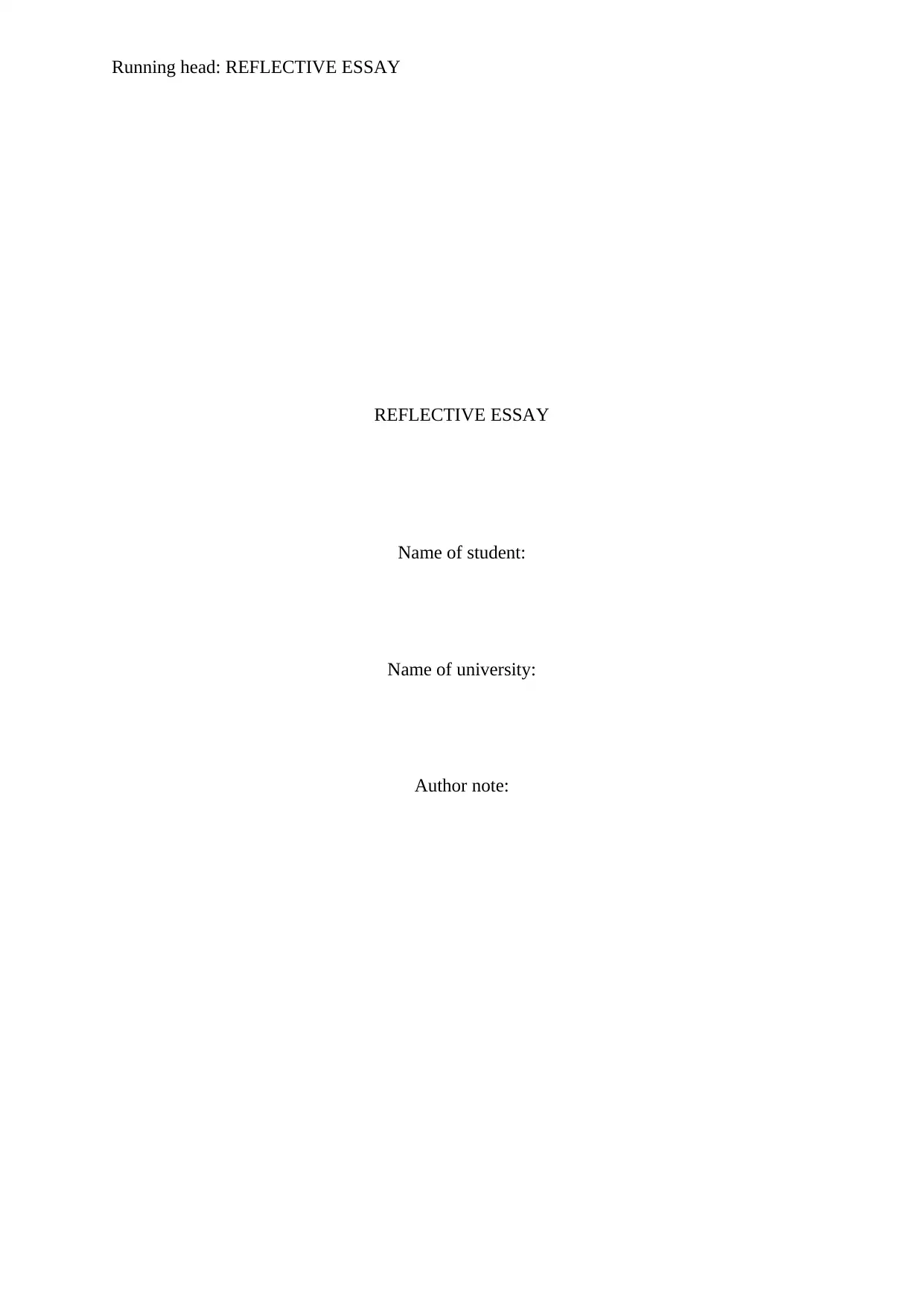
Running head: REFLECTIVE ESSAY
REFLECTIVE ESSAY
Name of student:
Name of university:
Author note:
REFLECTIVE ESSAY
Name of student:
Name of university:
Author note:
Secure Best Marks with AI Grader
Need help grading? Try our AI Grader for instant feedback on your assignments.
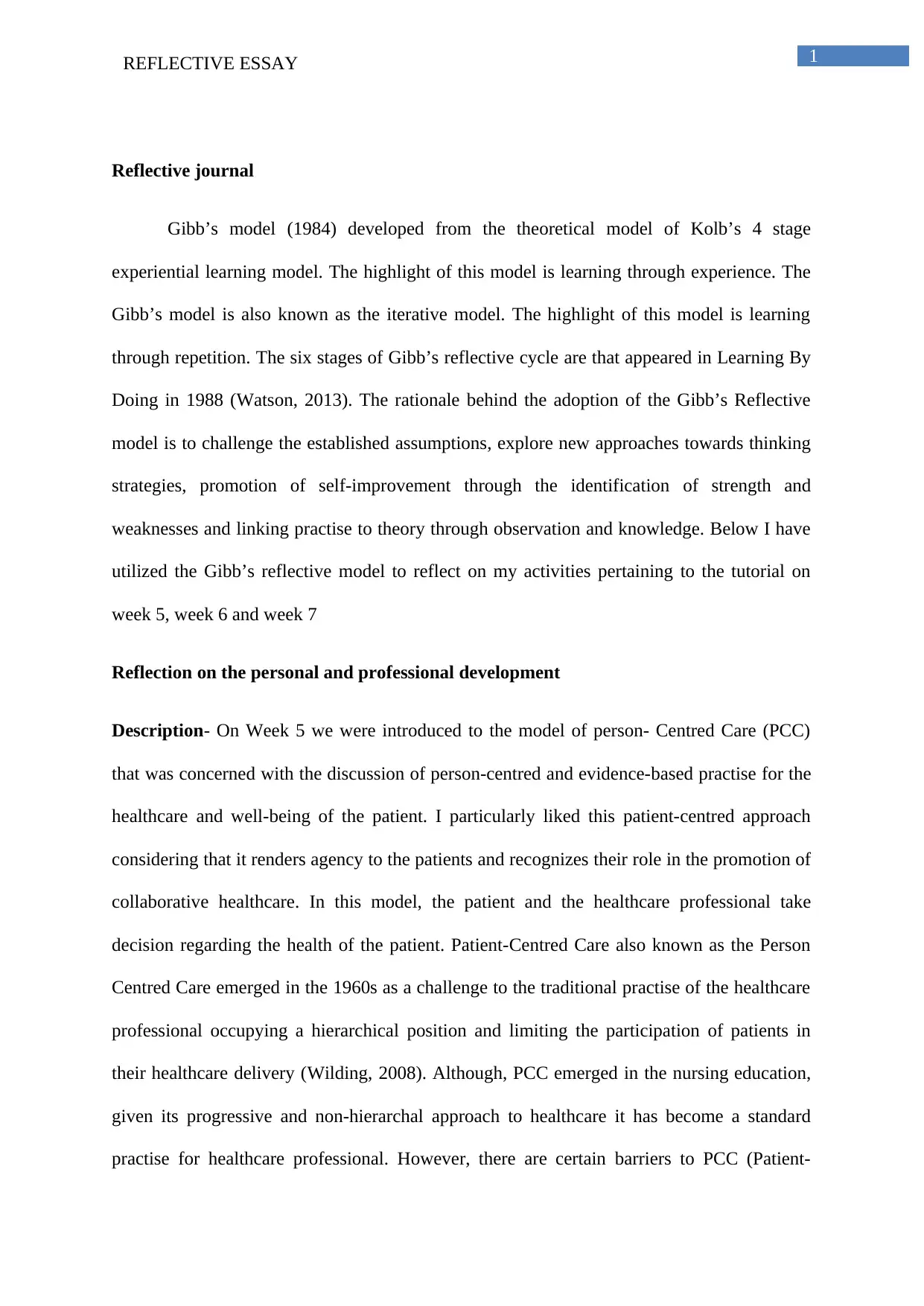
1REFLECTIVE ESSAY
Reflective journal
Gibb’s model (1984) developed from the theoretical model of Kolb’s 4 stage
experiential learning model. The highlight of this model is learning through experience. The
Gibb’s model is also known as the iterative model. The highlight of this model is learning
through repetition. The six stages of Gibb’s reflective cycle are that appeared in Learning By
Doing in 1988 (Watson, 2013). The rationale behind the adoption of the Gibb’s Reflective
model is to challenge the established assumptions, explore new approaches towards thinking
strategies, promotion of self-improvement through the identification of strength and
weaknesses and linking practise to theory through observation and knowledge. Below I have
utilized the Gibb’s reflective model to reflect on my activities pertaining to the tutorial on
week 5, week 6 and week 7
Reflection on the personal and professional development
Description- On Week 5 we were introduced to the model of person- Centred Care (PCC)
that was concerned with the discussion of person-centred and evidence-based practise for the
healthcare and well-being of the patient. I particularly liked this patient-centred approach
considering that it renders agency to the patients and recognizes their role in the promotion of
collaborative healthcare. In this model, the patient and the healthcare professional take
decision regarding the health of the patient. Patient-Centred Care also known as the Person
Centred Care emerged in the 1960s as a challenge to the traditional practise of the healthcare
professional occupying a hierarchical position and limiting the participation of patients in
their healthcare delivery (Wilding, 2008). Although, PCC emerged in the nursing education,
given its progressive and non-hierarchal approach to healthcare it has become a standard
practise for healthcare professional. However, there are certain barriers to PCC (Patient-
Reflective journal
Gibb’s model (1984) developed from the theoretical model of Kolb’s 4 stage
experiential learning model. The highlight of this model is learning through experience. The
Gibb’s model is also known as the iterative model. The highlight of this model is learning
through repetition. The six stages of Gibb’s reflective cycle are that appeared in Learning By
Doing in 1988 (Watson, 2013). The rationale behind the adoption of the Gibb’s Reflective
model is to challenge the established assumptions, explore new approaches towards thinking
strategies, promotion of self-improvement through the identification of strength and
weaknesses and linking practise to theory through observation and knowledge. Below I have
utilized the Gibb’s reflective model to reflect on my activities pertaining to the tutorial on
week 5, week 6 and week 7
Reflection on the personal and professional development
Description- On Week 5 we were introduced to the model of person- Centred Care (PCC)
that was concerned with the discussion of person-centred and evidence-based practise for the
healthcare and well-being of the patient. I particularly liked this patient-centred approach
considering that it renders agency to the patients and recognizes their role in the promotion of
collaborative healthcare. In this model, the patient and the healthcare professional take
decision regarding the health of the patient. Patient-Centred Care also known as the Person
Centred Care emerged in the 1960s as a challenge to the traditional practise of the healthcare
professional occupying a hierarchical position and limiting the participation of patients in
their healthcare delivery (Wilding, 2008). Although, PCC emerged in the nursing education,
given its progressive and non-hierarchal approach to healthcare it has become a standard
practise for healthcare professional. However, there are certain barriers to PCC (Patient-

2REFLECTIVE ESSAY
Centred Care) and those are skill-mix, focussing on the skill-based models of care and
focusing on the funding for the throughput (Timmins & O'Shea, 2014). It has been found that
less qualified professionals are rendered with high responsibility or the absence of adequate
nurses to take care of the resident patients. Another recognized barrier is the allocation of
tasks to different nurses instead of taking care of the patients and understanding their unique
needs. The organizational culture is also found to be influential in determining the
environment for patient care and patient support
Feelings
During the initial period of my nurse training I had limited knowledge about nursing.
Secondly, I did not have the opportunity to muster practical adaptation of the model of Gibb’s
reflective cycle, clinical reasoning cycle, and Roper and Logan and Tierney Model of
clinical care. With the introduction of clinical reasoning cycle I realized about the
importance of the most appropriate clinical reasoning skills have appositive outcome on the
patient. This is found to be quite significant considering the large number of negative patient
outcome borne by the patients due to the incompetency of the nurses. I was not aware about
the Roper-Logan-Tierney Model of living that I found to be redolent of the patient-centred
care approach. This model promotes the autonomy of the patients and assess the change that
occurred in their lives post illness and injury (Higgs, 2008). I learnt about the five key factors
of biological, sociocultural, environmental, politicieconomical and psychological factors are
important inform the theory of nursing with the aim of making it a holistic model. I realized
the importance of daily living in the assessment of the patient. On week 7 we were introduced
to the Clinical Reasoning Cycle that elaborated on the reflection and fostered critical thinking
in the delivery of healthcare service. I was introduced to the five kinds of emotional stressors
those are social support networks, centre of control, life perspective, emotional control and
preparation for stress
Centred Care) and those are skill-mix, focussing on the skill-based models of care and
focusing on the funding for the throughput (Timmins & O'Shea, 2014). It has been found that
less qualified professionals are rendered with high responsibility or the absence of adequate
nurses to take care of the resident patients. Another recognized barrier is the allocation of
tasks to different nurses instead of taking care of the patients and understanding their unique
needs. The organizational culture is also found to be influential in determining the
environment for patient care and patient support
Feelings
During the initial period of my nurse training I had limited knowledge about nursing.
Secondly, I did not have the opportunity to muster practical adaptation of the model of Gibb’s
reflective cycle, clinical reasoning cycle, and Roper and Logan and Tierney Model of
clinical care. With the introduction of clinical reasoning cycle I realized about the
importance of the most appropriate clinical reasoning skills have appositive outcome on the
patient. This is found to be quite significant considering the large number of negative patient
outcome borne by the patients due to the incompetency of the nurses. I was not aware about
the Roper-Logan-Tierney Model of living that I found to be redolent of the patient-centred
care approach. This model promotes the autonomy of the patients and assess the change that
occurred in their lives post illness and injury (Higgs, 2008). I learnt about the five key factors
of biological, sociocultural, environmental, politicieconomical and psychological factors are
important inform the theory of nursing with the aim of making it a holistic model. I realized
the importance of daily living in the assessment of the patient. On week 7 we were introduced
to the Clinical Reasoning Cycle that elaborated on the reflection and fostered critical thinking
in the delivery of healthcare service. I was introduced to the five kinds of emotional stressors
those are social support networks, centre of control, life perspective, emotional control and
preparation for stress
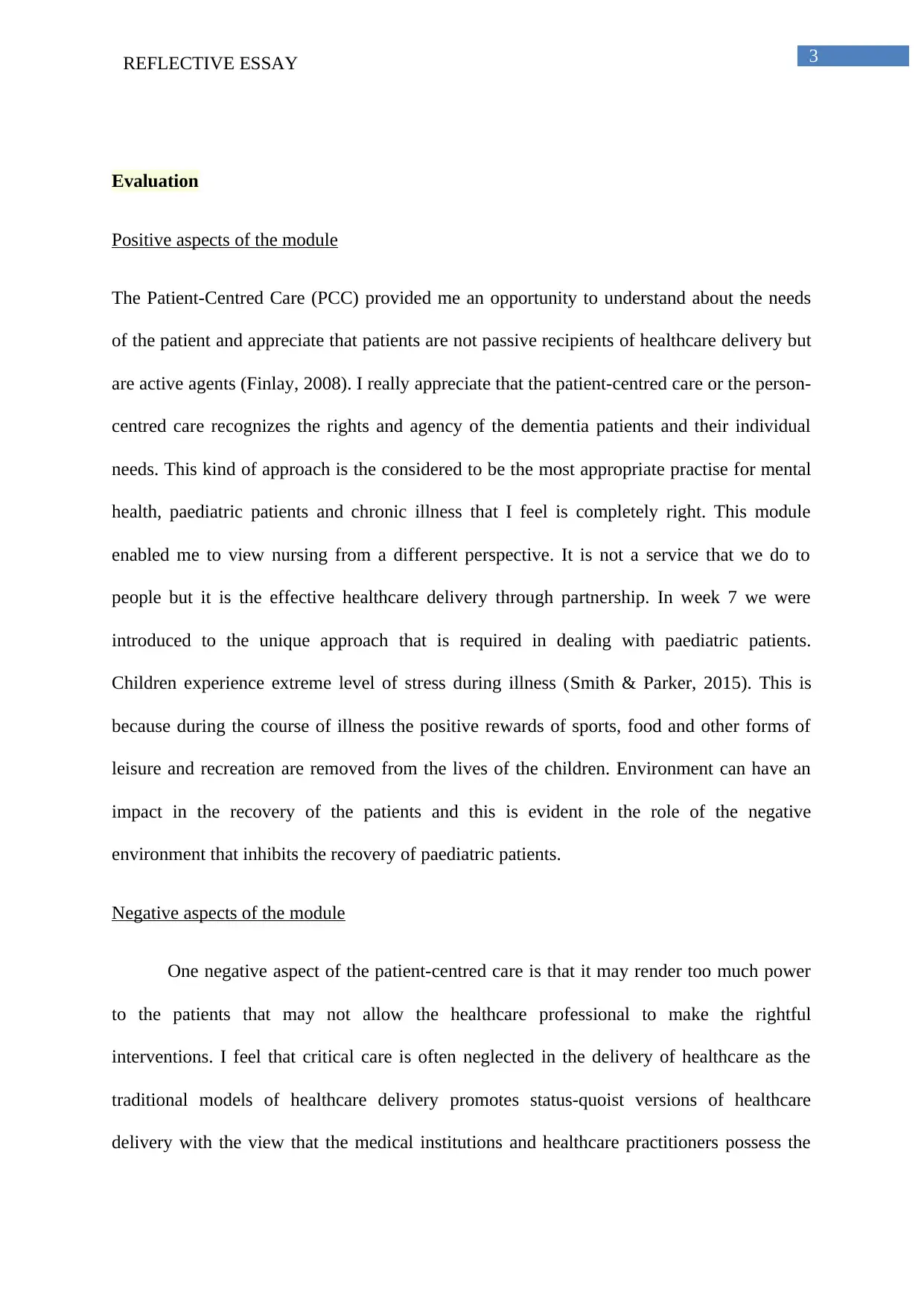
3REFLECTIVE ESSAY
Evaluation
Positive aspects of the module
The Patient-Centred Care (PCC) provided me an opportunity to understand about the needs
of the patient and appreciate that patients are not passive recipients of healthcare delivery but
are active agents (Finlay, 2008). I really appreciate that the patient-centred care or the person-
centred care recognizes the rights and agency of the dementia patients and their individual
needs. This kind of approach is the considered to be the most appropriate practise for mental
health, paediatric patients and chronic illness that I feel is completely right. This module
enabled me to view nursing from a different perspective. It is not a service that we do to
people but it is the effective healthcare delivery through partnership. In week 7 we were
introduced to the unique approach that is required in dealing with paediatric patients.
Children experience extreme level of stress during illness (Smith & Parker, 2015). This is
because during the course of illness the positive rewards of sports, food and other forms of
leisure and recreation are removed from the lives of the children. Environment can have an
impact in the recovery of the patients and this is evident in the role of the negative
environment that inhibits the recovery of paediatric patients.
Negative aspects of the module
One negative aspect of the patient-centred care is that it may render too much power
to the patients that may not allow the healthcare professional to make the rightful
interventions. I feel that critical care is often neglected in the delivery of healthcare as the
traditional models of healthcare delivery promotes status-quoist versions of healthcare
delivery with the view that the medical institutions and healthcare practitioners possess the
Evaluation
Positive aspects of the module
The Patient-Centred Care (PCC) provided me an opportunity to understand about the needs
of the patient and appreciate that patients are not passive recipients of healthcare delivery but
are active agents (Finlay, 2008). I really appreciate that the patient-centred care or the person-
centred care recognizes the rights and agency of the dementia patients and their individual
needs. This kind of approach is the considered to be the most appropriate practise for mental
health, paediatric patients and chronic illness that I feel is completely right. This module
enabled me to view nursing from a different perspective. It is not a service that we do to
people but it is the effective healthcare delivery through partnership. In week 7 we were
introduced to the unique approach that is required in dealing with paediatric patients.
Children experience extreme level of stress during illness (Smith & Parker, 2015). This is
because during the course of illness the positive rewards of sports, food and other forms of
leisure and recreation are removed from the lives of the children. Environment can have an
impact in the recovery of the patients and this is evident in the role of the negative
environment that inhibits the recovery of paediatric patients.
Negative aspects of the module
One negative aspect of the patient-centred care is that it may render too much power
to the patients that may not allow the healthcare professional to make the rightful
interventions. I feel that critical care is often neglected in the delivery of healthcare as the
traditional models of healthcare delivery promotes status-quoist versions of healthcare
delivery with the view that the medical institutions and healthcare practitioners possess the
Secure Best Marks with AI Grader
Need help grading? Try our AI Grader for instant feedback on your assignments.
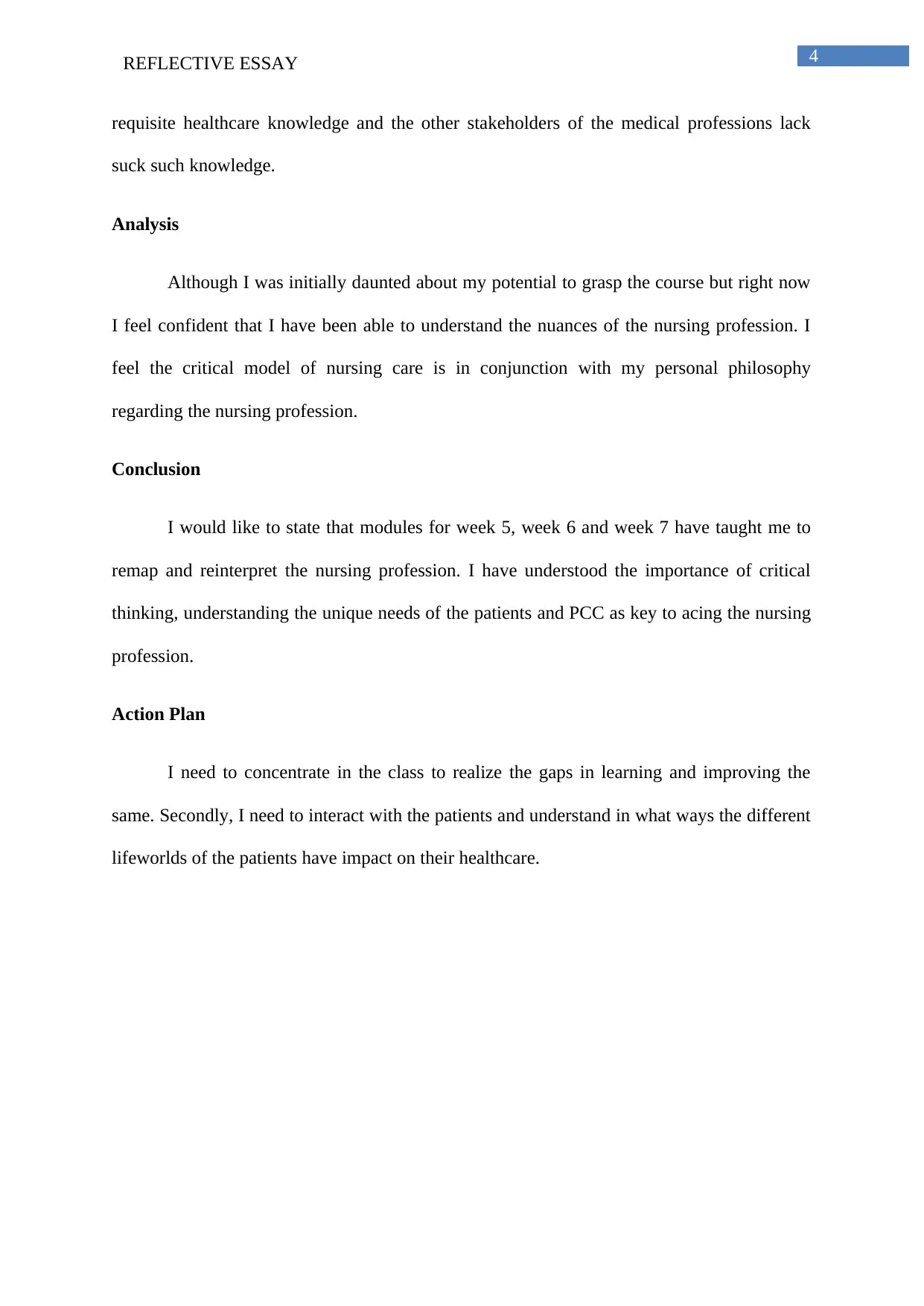
4REFLECTIVE ESSAY
requisite healthcare knowledge and the other stakeholders of the medical professions lack
suck such knowledge.
Analysis
Although I was initially daunted about my potential to grasp the course but right now
I feel confident that I have been able to understand the nuances of the nursing profession. I
feel the critical model of nursing care is in conjunction with my personal philosophy
regarding the nursing profession.
Conclusion
I would like to state that modules for week 5, week 6 and week 7 have taught me to
remap and reinterpret the nursing profession. I have understood the importance of critical
thinking, understanding the unique needs of the patients and PCC as key to acing the nursing
profession.
Action Plan
I need to concentrate in the class to realize the gaps in learning and improving the
same. Secondly, I need to interact with the patients and understand in what ways the different
lifeworlds of the patients have impact on their healthcare.
requisite healthcare knowledge and the other stakeholders of the medical professions lack
suck such knowledge.
Analysis
Although I was initially daunted about my potential to grasp the course but right now
I feel confident that I have been able to understand the nuances of the nursing profession. I
feel the critical model of nursing care is in conjunction with my personal philosophy
regarding the nursing profession.
Conclusion
I would like to state that modules for week 5, week 6 and week 7 have taught me to
remap and reinterpret the nursing profession. I have understood the importance of critical
thinking, understanding the unique needs of the patients and PCC as key to acing the nursing
profession.
Action Plan
I need to concentrate in the class to realize the gaps in learning and improving the
same. Secondly, I need to interact with the patients and understand in what ways the different
lifeworlds of the patients have impact on their healthcare.
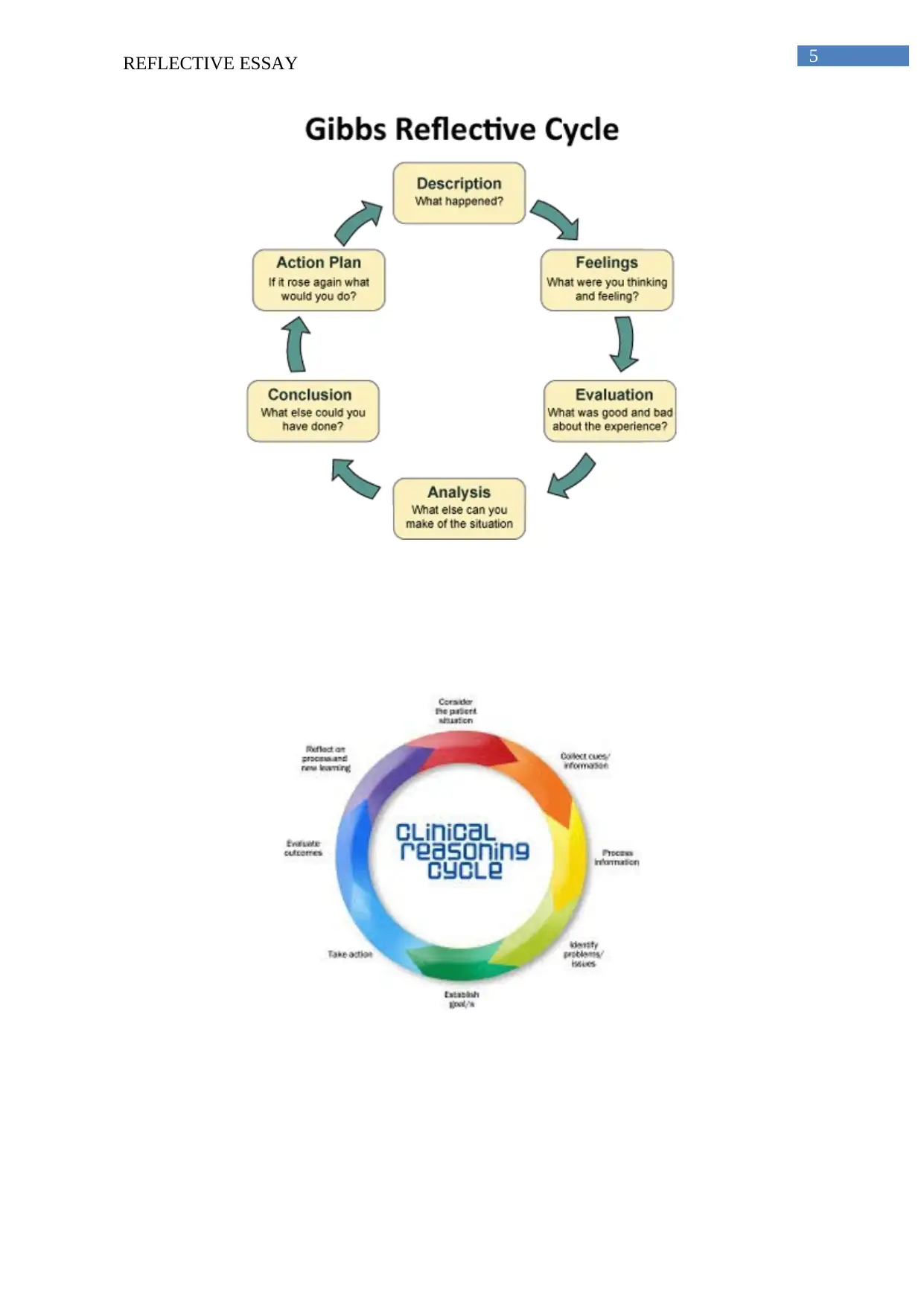
5REFLECTIVE ESSAY
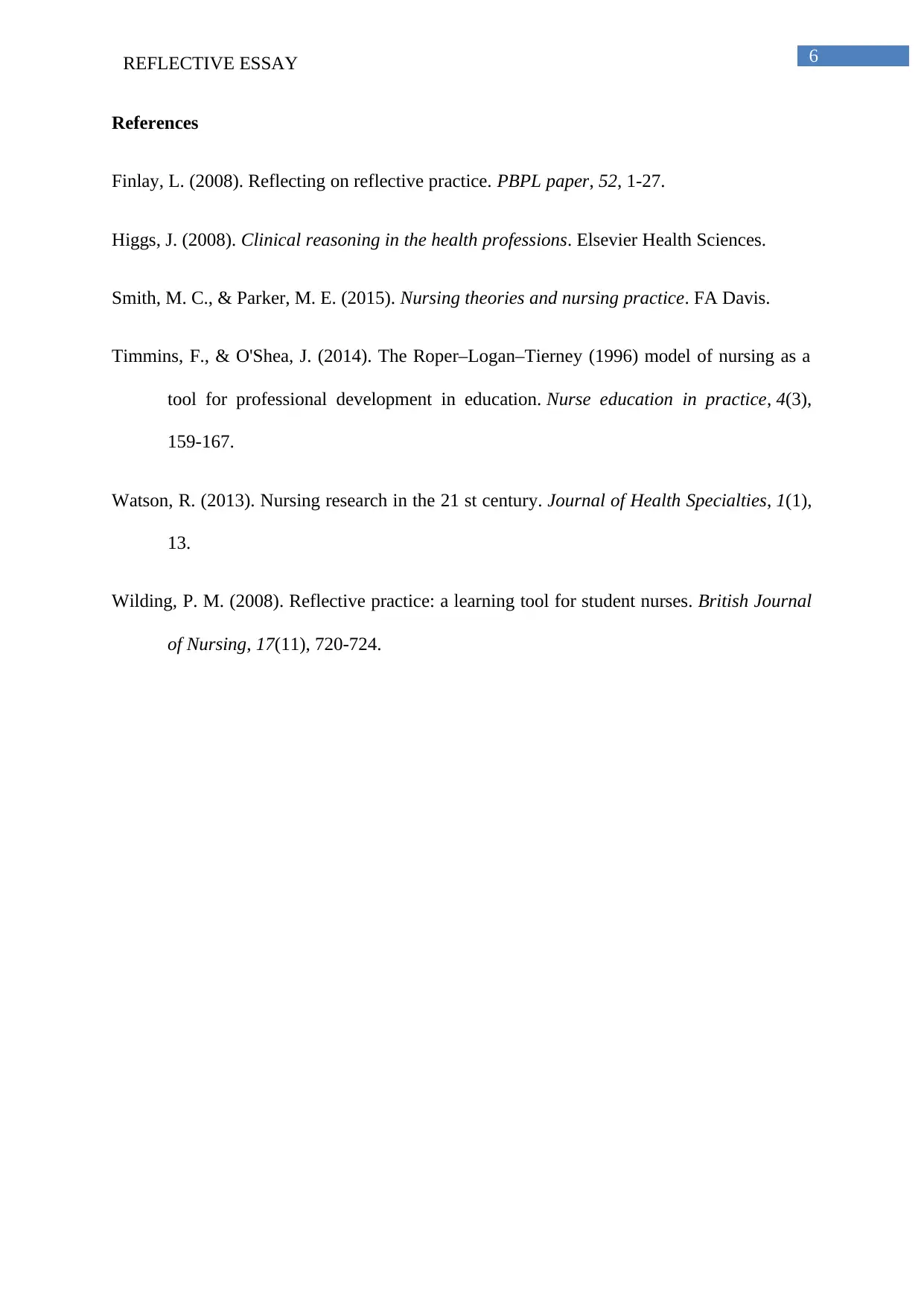
6REFLECTIVE ESSAY
References
Finlay, L. (2008). Reflecting on reflective practice. PBPL paper, 52, 1-27.
Higgs, J. (2008). Clinical reasoning in the health professions. Elsevier Health Sciences.
Smith, M. C., & Parker, M. E. (2015). Nursing theories and nursing practice. FA Davis.
Timmins, F., & O'Shea, J. (2014). The Roper–Logan–Tierney (1996) model of nursing as a
tool for professional development in education. Nurse education in practice, 4(3),
159-167.
Watson, R. (2013). Nursing research in the 21 st century. Journal of Health Specialties, 1(1),
13.
Wilding, P. M. (2008). Reflective practice: a learning tool for student nurses. British Journal
of Nursing, 17(11), 720-724.
References
Finlay, L. (2008). Reflecting on reflective practice. PBPL paper, 52, 1-27.
Higgs, J. (2008). Clinical reasoning in the health professions. Elsevier Health Sciences.
Smith, M. C., & Parker, M. E. (2015). Nursing theories and nursing practice. FA Davis.
Timmins, F., & O'Shea, J. (2014). The Roper–Logan–Tierney (1996) model of nursing as a
tool for professional development in education. Nurse education in practice, 4(3),
159-167.
Watson, R. (2013). Nursing research in the 21 st century. Journal of Health Specialties, 1(1),
13.
Wilding, P. M. (2008). Reflective practice: a learning tool for student nurses. British Journal
of Nursing, 17(11), 720-724.
1 out of 7
Related Documents
Your All-in-One AI-Powered Toolkit for Academic Success.
+13062052269
info@desklib.com
Available 24*7 on WhatsApp / Email
![[object Object]](/_next/static/media/star-bottom.7253800d.svg)
Unlock your academic potential
© 2024 | Zucol Services PVT LTD | All rights reserved.




